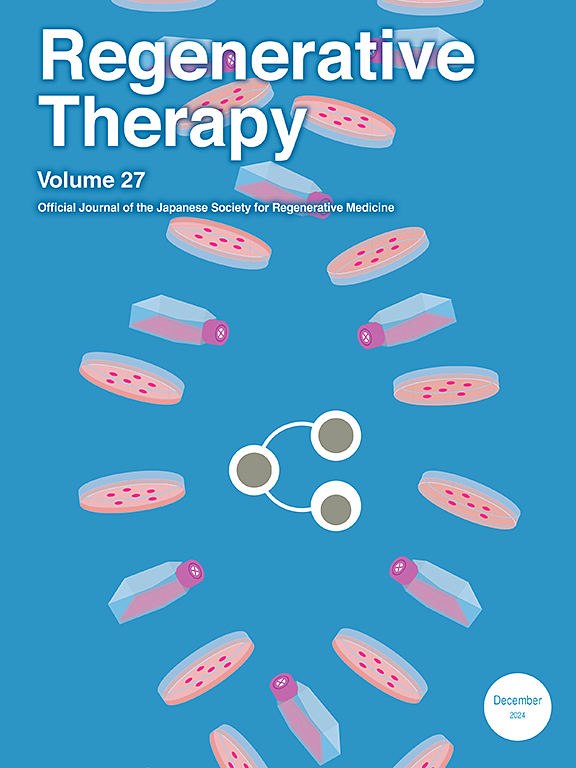过度表达人类生长激素的脂肪源性干细胞通过ERK通路增强成纤维细胞活性并加速烧伤创面愈合
IF 3.5
3区 环境科学与生态学
Q3 CELL & TISSUE ENGINEERING
引用次数: 0
摘要
目的:人生长激素(HGH)通过促进细胞增殖、血管生成和组织再生来促进伤口愈合。本研究探讨了过表达hgh的脂肪源性干细胞(HGH-ADSCs)对成纤维细胞功能、ERK通路激活和烧伤创面愈合的影响。方法从脂肪组织中分离sadscs,通过CD标记表达进行鉴定,并通过油红O(脂肪形成)、茜素红S(成骨)和阿利新蓝染色(软骨形成)证实其多能性。然后用携带HGH的慢病毒载体转导ADSCs,生成HGH-ADSCs,并通过qRT-PCR证实。成纤维细胞(HDF-a)在hgh - adscs条件培养基和adscs条件培养基中共培养,以评估增殖(MTT试验)、迁移和侵袭(Transwell)、凋亡(流式细胞术)和G0/G1细胞周期进展。Western blotting检测ERK活化,SCH772984 (ERK抑制剂)检测通路依赖性。采用HGH-ADSCs、ADSCs、生理盐水三组治疗大鼠烧伤模型。组织病理学(H&;E, TUNEL染色)分析上皮再生和凋亡。ELISA和生化分析定量了伤口组织匀浆中的TNF-α、IL-1β、IL-6、MDA、SOD和CAT。结果shgh - adscs显著增强成纤维细胞增殖、迁移、侵袭,延长G0/G1期,减少细胞凋亡(P <;0.05)。ERK抑制消除了这些影响(P <;0.05)。在体内,HGH-ADSCs加速伤口愈合(P <;0.05),上皮化增强,炎症减少,胶原形成增加。炎症因子(TNF-α, IL-1β, IL-6)和MDA在hgh - adsc处理的伤口中最低,SOD和CAT在hgh - adsc处理的伤口中最高(P <;0.05)。结论过表达HGH的adscs促进成纤维细胞活性,激活ERK信号,促进烧伤创面愈合,具有较强的治疗潜力。本文章由计算机程序翻译,如有差异,请以英文原文为准。
Human growth hormone-overexpressing adipose-derived stem cells enhance fibroblast activity and accelerate burn wound healing via ERK pathway therapeutic potential of ADSCs in burn wound repair
Objective
Human growth hormone (HGH) enhances wound healing by promoting cell proliferation, angiogenesis, and tissue regeneration. This study investigated the effects of HGH-overexpressing Adipose-derived stem cells (HGH-ADSCs) on fibroblast function, ERK pathway activation, and burn wound healing.
Methods
ADSCs were isolated from adipose tissue, characterized via CD marker expression, and confirmed for multipotency using Oil Red O (adipogenesis), Alizarin Red S (osteogenesis), and Alcian Blue staining (chondrogenesis). ADSCs were then transduced with a lentiviral vector carrying HGH, generating HGH-ADSCs and confirmed by qRT-PCR. Fibroblasts (HDF-a) were co-cultured were co-cultured under HGH-ADSCs-conditioned medium and ADSCs-conditioned medium to assess proliferation (MTT assay), migration and invasion (Transwell), apoptosis (flow cytometry), and G0/G1 cell cycle progression. Western blotting determined ERK activation, and SCH772984 (ERK inhibitor) was used to confirm pathway dependency. A burn rat model was established with three treatment groups: HGH-ADSCs, ADSCs, and saline. and histopathology (H&E, TUNEL staining) analyzed epithelial regeneration and apoptosis. ELISA and biochemical assays quantified TNF-α, IL-1β, IL-6, MDA, SOD, and CAT in wound tissue homogenates.
Results
HGH-ADSCs significantly enhanced fibroblast proliferation, migration, invasion, and prolonged G0/G1 phase while reducing apoptosis (P < 0.05). ERK inhibition abolished these effects (P < 0.05). In vivo, HGH-ADSCs accelerated wound closure (P < 0.05), enhanced epithelialization, reduced inflammation, and increased collagen formation. Inflammatory cytokines (TNF-α, IL-1β, IL-6) and MDA were lowest, while SOD and CAT were highest in HGH-ADSC-treated wounds (P < 0.05).
Conclusion
ADSCs overexpressing HGH promote fibroblast activity, activate ERK signaling, and accelerate burn wound healing, demonstrating strong therapeutic potential.
求助全文
通过发布文献求助,成功后即可免费获取论文全文。
去求助
来源期刊

Regenerative Therapy
Engineering-Biomedical Engineering
CiteScore
6.00
自引率
2.30%
发文量
106
审稿时长
49 days
期刊介绍:
Regenerative Therapy is the official peer-reviewed online journal of the Japanese Society for Regenerative Medicine.
Regenerative Therapy is a multidisciplinary journal that publishes original articles and reviews of basic research, clinical translation, industrial development, and regulatory issues focusing on stem cell biology, tissue engineering, and regenerative medicine.
 求助内容:
求助内容: 应助结果提醒方式:
应助结果提醒方式:


